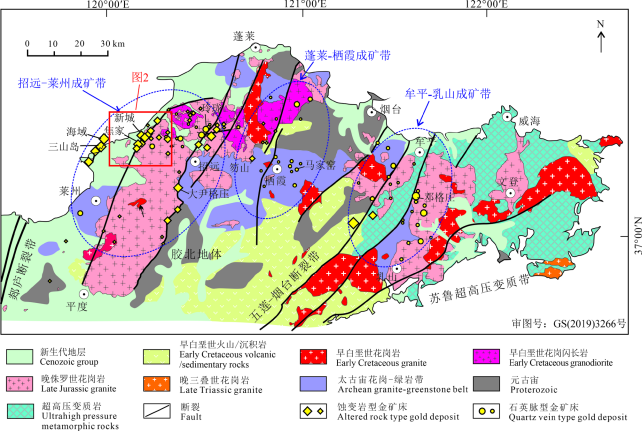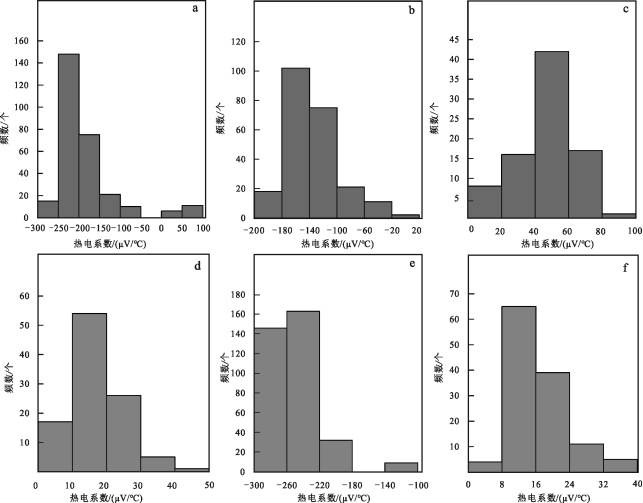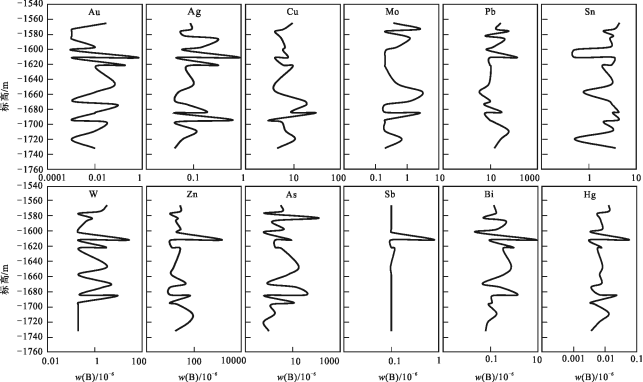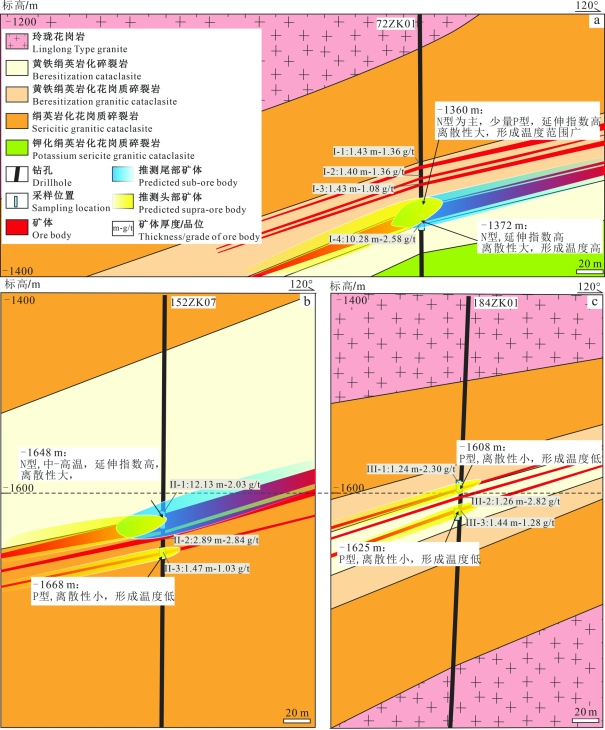-
胶东金矿集区已探明金矿资源量>5400 t,为中国第一大金矿集区和世界第三大金矿集区,是重要的黄金资源产地(Deng et al., 2020;于晓卫等,2023)。胶东金矿集区从东至西分为3大金成矿带,分别为牟平-乳山带、蓬莱-栖霞带和招远-莱州带(图1)。其中,莱州-招远带为胶东金矿集区最为重要的金成矿带,三山岛断裂带、焦家断裂带和招平断裂带控制了该区域的主要金矿床,其资源量占了胶东金矿集区的三分之二(Fan et al., 2005;Cai et al., 2018)。三山岛-仓上断裂带主要控制了三山岛、新立、仓上及西岭等超大型金矿床,焦家-新城断裂带主要控制了焦家、新城、寺庄、纱岭等超大型金矿床,招远-平度断裂带控制了玲珑、大尹格庄、夏甸等大型、超大型金矿床。前人对胶东金矿床进行了大量的研究工作,建立了众多矿床成因模型,如非造山型金矿床(Zhai et al., 2004)、克拉通破坏型金矿床(Zhu et al., 2015)、胶东型金矿床(Li et al., 2015;Deng et al., 2015; 2020),以及造山型金矿床(Groves et al., 2020)等。由于胶东地区复杂的构造系统,如变质核杂岩、断陷盆地及张性断层等伸展构造,学者们提出了胶东型热隆-伸展金成矿系统的概念,壳幔混合对胶东巨量金矿床的形成起着重要作用,另外,120~116 Ma的伟德山型贫金花岗质岩浆也是金矿同期(~120 Ma)形成的产物(宋明春等,2023;Song et al., 2023)。对矿床成因研究的终极目标是为了有效地指导找矿勘查,因此,近些年的工作越来越多地集中于成矿潜力研究方面,如利用原生晕地球化学、流体包裹体、大数据三维地质建模及黄铁矿热电性等方法对胶东金矿床的成矿潜力和找矿前景进行评估。
胶东金矿早期的勘查工作多集中于-500 m以浅的区域,深部区域的找矿工作自2005年以来已新增金矿储量2700多t(宋明春等,2015;Song et al., 2015)。焦家带上陆续探明了新城、曲家、东季-南吕、南吕-欣木及前陈上杨家等十几处大-超大型金矿床,找矿勘查工作的不断突破显示了该带上巨大的金资源潜力,前人大量的地、物、化、遥和科研成果使得该区域的研究程度相对较高,但主要集中于浅部区域(-600 m以浅),建立了焦家带浅部的金矿成矿与找矿模式。近些年,焦家成矿带深部的找矿勘探工作已初步完成,-2000~-600 m仍发现了大规模的高品位金矿床(>1300 t,Song et al., 2023),前人已在焦家带深部成矿特征和成矿规律方面作出初步总结。焦家金矿带上的金矿床从浅部各自独立成矿至深部连为一体,为一个金成矿系统的产物,前人通过成矿地质特征的解剖以及流体包裹体、H-O-S同位素等的研究认为矿床成因独特,为焦家型金矿床(Song et al.,2014),属于胶东地区蚀变岩型金矿床的代表(李杰等,2020)。浅部看似相互独立的矿床,在深部实则连为一体,且深-浅部矿体具有较好的连续性(宋国政等,2017)。于学峰等(2019)团队实施的3266.06 m的科研钻孔验证了焦家金成矿带深部矿体的厚度和金品位仍然较好,平均品位1.85×10-6,而最高品位可达13.65×10-6。深部找矿勘查工作揭示了焦家断裂带和三山岛断裂带的金矿床深部主矿体相互连接为一体,但分别沿断裂带产出,在剖面上形成了从浅部至深部的2个缓倾斜赋矿台阶(宋明春等,2019; Song et al., 2023)。
黄铁矿是重要的载金矿物和标型矿物,其标型特征和热电性常用来指导找矿勘查工作,特别是对深部盲矿体的潜力评价具有一定的指示意义(陈高远等,1989;李胜荣等,1993;申俊峰等,2013)。前人利用黄铁矿热电性对胶东地区的金矿床进行成矿潜力评价取得了不错的效果,如在最早期的三山岛和乳山等金矿床的找矿预测工作中黄铁矿热电性起到了重要的指示作用(陈光远等,1989;李胜荣等,1993),于洪军等(2011)利用黄铁矿热电性并结合其微量元素标型特征对玲珑金矿床深部矿化体进行评价。前人对于焦家带上的金矿床也进行过黄铁矿热电性的研究,如徐瑞英等(2012)、戢兴忠等(2013)以及王碧雪(2013)对焦家带-600 m以浅的金矿床进行黄铁矿热电性特征的讨论,认为-600 m以深具有较好的找矿前景。近些年,吴晋超等(2021)利用新研发的原位黄铁矿热电性测试方法对黑岚沟金矿床进行了研究,取得了不错的找矿预测效果。原位的黄铁矿热电性测试方法,避免了传统热电性测试中容易混杂的部分,如黄铁矿的阶段世代和测试中的信噪比等,因此,可以更为精准高效地获得黄铁矿的热电性信息,更有利于准确地对成矿潜力进行评价(吴晋超等,2020)。而招贤金矿床是焦家带深部新发现的超大型金矿床(>200 t),在-1000~-2000 m乃至更深都揭露了较厚的金矿体。目前,少量学者对招贤金矿床的成因进行了系列研究,主要包括招贤金矿的地质特征(王英鹏等,2022a)、金及其相关矿物化学组分(王英鹏等,2022b)、黄铁矿微量元素特征(Li et al., 2021)、S-He-Ar同位素特征(Xu et al., 2022)、流体包裹体特征(Li et al., 2023),而对于招贤金矿床成矿预测方面,Li等(2022)进行了三维地质建模方面的研究,揭露了矿体的侧伏延展情况。招贤金矿床是研究焦家深部矿化特征和评价找矿潜力的优质对象,其深部矿段的矿物学特征、成矿规律以及深部-超深部的资源潜力评价方面仍缺少系统的研究和梳理,仍需开展深入的科学研究工作,以使深部成矿和找矿认识实现突破。因此,笔者利用准确度更高的原位黄铁矿热电性测试法对焦家带深部的招贤金矿床进行研究。
本文以胶东焦家成矿带招贤金矿床为研究对象,采集了-1691~-1360 m标高的深部矿体样品,磨制用于SEM图像分析的激光片和原位黄铁矿热电性测试的特制铜导片,通过矿物学特征、成矿元素分带特征以及黄铁矿热电性特征进行讨论,拟查明招贤金矿床的硫化物特征并对成矿潜力进行评估。该项工作对于招贤金矿床的深部找矿工作具有指导意义,同时对于整个焦家带的找矿潜力乃至整个胶东金矿深部矿化潜力具有启示作用。
1区域地质概况华北克拉通东部地区以郯庐断裂带为界,分布了胶东金矿集区和辽东金矿集区。胶东地区(图1)主要由超高压变质岩石和前寒武系基底变质岩石构成,区域内中-新生代岩浆-构造作用较为发育。区内地层从老至新分别为前寒武系的胶东群、荆山群、粉子山群和蓬莱群、白垩系的莱阳群、青山群和王氏群、古近系的五图群、新近系的临朐群和第四系沉积物。区内的岩浆岩主要形成自中生代。其中,晚侏罗世的壳源深熔钙碱性花岗岩(160~140 Ma)出露最为广泛,如玲珑花岗岩和昆嵛山花岗岩,该类岩体横跨苏鲁地体和胶北隆起呈东西向分布(Yang et al., 2012),岩性主要为二长花岗岩;其次,为早白垩世(130~126 Ma)的郭家岭花岗岩,主要为似斑状花岗闪长岩-二长花岗岩,具有壳幔混源和高钾钙碱性特征,分布于郭家岭-三山岛地区(Li et al., 2019)。另外,早白垩世晚期出露了与金矿床近同期形成的伟德山花岗岩(123~110 Ma),主要岩性为闪长岩-斑状二长花岗岩,为典型的壳幔混合型花岗质岩石(宋明春等,2015)。最晚期形成的岩浆岩为崂山花岗岩体(120~100 Ma),具有碱性花岗岩的特征(赵广涛等,1997;Li et al., 2019)。区内的构造活动以断裂为主,发育NNE向、NE向、EW向和NW向等多组断裂带,其中,以NE向-NNE向为主。胶东金矿床的主要控矿断裂构造为招平断裂、焦家断裂,以及三山岛断裂,各大断裂带规模较大,控制了区内绝大多数大型-超大型金矿床的分布。焦家断裂带的金矿床产状为SW倾向和S侧伏向,且表现为左列式展布,三山岛断裂带的金矿床产状为NE倾向和N侧伏向,且表现为向右的列式分布特征(宋明春等,2019)。
图1胶东地区地质简图(据Fan et al., 2003;宋明春,2023修改)
Fig. 1 Simplified geological map of the Jiaodong area (modified after Fan et al., 2003; Song et al., 2023)
2矿床地质特征焦家断裂带分布了大量金矿床,其中招贤金矿床位于该构造带的中段西南部分(图2)。
2.1矿区地质矿区地层以第四系沉积物为主,钻孔揭露的基岩以新元古代和中生代岩石为主。新太古代岩石主要由变辉长岩和英云闪长岩组成,而中生代花岗质岩石主要为郭家岭和玲珑花岗岩。其中,玲珑片麻状中粒含黑云二长花岗岩为主要赋矿围岩,多分布于断裂带下盘,而变质岩系分布于上盘。区内脉岩也有少量发育,如闪长玢岩、煌斑岩和辉绿玢岩等。
焦家断裂带为控矿构造,从主干断裂向西延伸至招贤金矿区深部,矿区内的断裂带长度约5400 m,宽度约160~500 m,钻孔控制的局部斜深约660 m,垂深约2400 m,走向为0°~30°,倾向W-NW,倾角19°~27°,从焦家断裂地表出露位置至招贤矿区钻孔控制的总斜深超过3000 m。断裂带整体呈下缓上陡的铲式构造形态。
2.2矿体特征招贤金矿床由30余个金矿体组成,分为4个矿体群(Ⅰ、Ⅱ、Ⅲ、Ⅳ)。Ⅰ号矿体群组产出于断裂破碎带下盘的黄铁绢英岩化蚀变岩中,其中,Ⅰ-1和Ⅰ-2矿体为主干矿体,两者的资源量占整个矿床资源量的一半以上;Ⅱ号矿体群组产出于Ⅰ号的下方,Ⅲ号矿体群组产出于Ⅱ号的下方,二者均产于黄铁绢英岩化蚀变碎裂岩中,资源量分别占总量的23.34%和8.65%;Ⅳ号矿体群组的资源量较少,约占总量的3.85%,其产出位置在更深部断裂面的上盘,整体处于其他3组矿体的下方。
图2焦家金成矿带招贤金矿区地质简图(据Li et al.,2021)
Fig. 2 Geological map of the Zhaoxian gold deposit, Jiaojia gold belt (after Li et al.,2021)
矿体呈脉状、似层状、透镜状,其产状与断裂面较为一致,可见矿体分支复合和夹缩膨胀的特征(图3)。断裂破碎带的围岩蚀变发育,为硅化、钾化、绿泥石化、绢云母化以及碳酸盐化。招贤金矿床根据矿物共生组合和矿脉穿切关系,可分为4个成矿阶段,分别为第一阶段的白色石英脉,第二阶段的灰色石英-黄铁矿细脉和网脉,第三阶段的灰色石英-多金属硫化物脉,以及第四阶段的石英-碳酸盐脉。其中,二、三阶段为主要成矿阶段。矿石金属矿物主要包括黄铁矿、黄铜矿、银金矿、闪锌矿、方铅矿、磁黄铁矿等,非金属矿物主要包括石英、方解石、绢云母、独居石等,黄铁矿是主要的载金矿物。
3样品及分析方法招贤金矿床主要为钻孔揭露,因此笔者对各勘探线剖面的钻孔岩芯进行了详细的观察,并选择了深部矿化现象较好的钻孔进行了样品采集。采样位置分别为钻孔184ZK01的-1731.0~-1560.0 m、152ZK07的-1691.3~-1565 m以及72ZK01的-1372.0~-1359.6 m(图3)。本次研究对各标高的样品进行了显微镜及扫描电镜的观察分析,并挑取了钻孔72ZK01的-1372 m和-1362 m标高、钻孔184ZK01的-1625 m和-1608 m标高以及钻孔152ZK07的-1648 m和-1668 m标高的矿石样品进行原位黄铁矿热电性测试。
本次研究在3个钻孔中挑选出新鲜的矿石样品磨制激光片并进行显微镜和扫面电镜(SEM)的观察分析。扫面电镜分析及图像拍摄在中国科学院地质与地球物理研究所矿产资源研究重点实验室完成。笔者使用配备了能量色散X射线光谱仪(EDS)的飞纳XL扫描电镜进行背散射图像(BSE)的拍摄,其加速电压为15 kV,波束电流为3~4 nA。每张BSE图像的采集时间为1 min,矿物半定量点分析时间为30 s。
图3招贤金矿床采样位置的钻孔柱状图
a.钻孔72ZK01剖面;b.钻孔152ZK07剖面;c.钻孔184ZK01剖面
Fig. 3 Drillhole column section of the Zhaoxian gold deposit showing the mineralized zone morphology and sampling site
a. Drillhole 72ZK01 section; b. Drillhole 152ZK07 section; c. Drillhole 184ZK01 section
图4招贤金矿床手标本及扫描电镜照片
a.第一阶段矿石手标本照片;b.第二阶段矿石手标本照片;c.第三阶段矿石手标本照片;d.第四阶段矿石手标本照片;e.黄铁矿和独居石共生的扫描电镜图像;f.黄铁矿中存在黄铜矿和金颗粒的包体的扫描电镜图像;g.黄铁矿、黄铜矿、方铅矿共生的扫描电镜图像;h.黄铁矿中自然金的扫描电镜图像;i.矿物单点能谱分析图
S1—第一阶段;S2—第二阶段;S3—第三阶段;S4—第四阶段;Qtz—石英;Py—黄铁矿;Gn—方铅矿;Sp—闪锌矿;Cal—方解石;Mnz—独居石;Cpy—黄铜矿;Au—自然金
Fig. 4 Photographs and SEM images of ore samples from the Zhaoxian gold deposit
a. Photograph of ore hand specimen in stage one; b. Photograph of ore hand specimen in stage two; c. Photograph of ore hand specimen in stage three; d. Photograph of ore hand specimen in stage four; e. SEM image of the symbiosis of pyrite and monazite; f. SEM image of chalcopyrite and gold inclusions in pyrite; g. SEM image of the symbiosis of pyrite, chalcopyrite, galena; h. SEM image of natural gold in pyrite; i. Single point
energy spectrum analysis of minerals
S1—Stage 1; S2—Stage 2; S3—Stage 3; S4—Stage 4; Qtz—Quartz; Py—Pyrite; Gn—Galena; Sp—Sphalerite; Cal—Calcite; Mnz—Monazite;
Cpy—Chalcopyrite; Au—Native gold
对3个钻孔中的6个不同标高的黄铁矿进行原位黄铁矿热电性测试,实验测试工作在南京航致测控设备有限公司完成。使用BHTE-8热电仪对黄铁矿热电系数的测试,实验环境温度保持在21℃,空气相对湿度保持在50%,设置仪器冷端温度为26~32℃,而热端温度为115~118℃,控制其活化温度85~89℃。通过实验测试和计算获得招贤金矿床黄铁矿的热电系数、热电势和导型(P/N型)。具体实验方法见吴晋超等(2020)和Wu等(2021)。通过测试计算,进一步得到招贤金矿床的矿体延伸指数和形成温度,其计算方法见讨论部分。
对招贤金矿床钻孔184ZK01的-1732~-1573 m标高和152ZK07的-1694~-1565 m标高的岩-矿石样品进行Au、Ag、Cu、Mo、Pb、Sn、W、Zn、As、Sb、Bi以及Hg的元素含量分析,实验测试在山东省第六地质矿产勘察院实验室完成,检测标准依据岩石地化样品DZ/T 0279-2016分析方法执行。具体实验方法见Li等(2016)。分析数据的元素相关性计算使用的是IBM SPSS Statistics 22软件,其计算原理和方法详见Templ等(2008)和Reimann等(2017)。
4实验结果(1)矿物学
招贤金矿床的成矿阶段和矿物共生组合与胶东众多金矿床一致,以石英为主要脉石矿物,黄铁矿等其他硫化物为主要的金属矿物,偶见自然金(图4a~h)。招贤金矿床的矿石以破碎蚀变岩型和细石英脉型为主。金矿物以银金矿为主,常以包体颗粒的形式被黄铁矿所包裹或者产于石英和黄铁矿裂隙之中(图4h、i)。扫描电镜图像显示出第二、三成矿阶段的细小黄铁矿颗粒附近常伴生热液独居石(图4e)、热液锆石以及金红石等副矿物。方铅矿和闪锌矿通常出现在第三阶段,它们不仅以单矿物颗粒的形式存在,还常常以包体微颗粒的形式赋存于黄铁矿颗粒之中(图4g)。在第三阶段偶见黄铜矿和闪锌矿共生出现的乳浊状结构。
(2)黄铁矿热电性
招贤金矿床不同标高的黄铁矿原位热电性测试结果见表1,共测试了137个黄铁矿颗粒,获得1174个点位数据。热电系数分布直方图见图5。
(3)成矿元素分析
招贤金矿床钻孔184ZK01和152ZK07依据不同标高共测试了22件全岩样品,其成矿元素分析测试结果见表2,其中编号1-13为钻孔184ZK01的样品,编号14-22为钻孔152ZK07的样品。
5讨论5.1黄铁矿热电系数黄铁矿的热电系数是原位热电性分析的重要参数之一,可通过热电系数的离散程度对金矿床的矿化强弱程度进行评价(邵洁涟,1988;李胜荣等,1996)。若黄铁矿的热电系数具有较大的离散程度,表明其发育较强的矿化作用,可能产出较高品位和较大规模的金矿体;反之,若其离散性不明显,热电系数值较集中则暗示其有限的成矿前景。招贤金矿床3个钻孔的6个不同标高的黄铁矿样品展示出不同的热电系数离散程度(图5,表1)。
从浅至深,标高-1360 m黄铁矿热电系数具有较宽的离散范围(-265.96~90.17μV/℃),标高-1372 m黄铁矿的热电系数离散范围在-204.43~-13.91μV/℃,标高-1608 m、-1625 m和-1668 m的黄铁矿热电系数离散范围较浅部标高的相对集中,范围分别为10.67~80.12μV/℃、8.07~40.81μV/℃和7.78~38.64μV/℃。而标高-1648 m黄铁矿显示较大的热电系数离散性,范围是-297.57~127.56μV/℃。招贤金矿床标高-1360 m较宽范围的热电系数离散性表明该段可能为矿化体首尾叠加部位,具有较高的金品位,标高-1372 m和-1648 m也具有相似的特点。而标高-1608 m、-1625 m和-1668 m相对其他标高具有相对集中的范围,暗示其可能为单一金矿体的首或尾部,具有一般的矿化强度。黄铁矿热电系数的离散程度研究反映了不同标高的矿体矿化强度具有一定差异性。
5.2黄铁矿热电性导型黄铁矿的热电性导型对金的运移沉淀具有重要影响,Mironov等(1981)进行的黄铁矿γ光谱和195Au同位素测量表明,负电型金配合物能否被黄铁矿晶格吸附受到As元素的控制,而As元素对黄铁矿的热电性导型具有决定性作用,因此,不同导型的黄铁矿对Au的吸附能力是不同的(曾志刚,1995)。黄铁矿的热电性导型分为失去外层电子的P型和载流子含额外电子的N型2种,其中,P型黄铁矿的吸附能力是受体阳离子激发的,Au元素更易被P导型的黄铁矿所吸附(Pridmore et al., 1976)。黄铁矿的热电性导型受各种微量元素的影响,Co和Ni等二价金属赋存于黄铁矿晶格中常会使黄铁矿表现为N型,而含As和Sb等元素则会促成P型(Morimoto,1992)。含As的黄铁矿晶格通常比游离态黄铁矿更大,P型率先吸附了金配合物,使P型黄铁矿晶格发生畸变,Au+会被还原为Au0,从而发生Au元素沉淀(Morimoto,1992;Fuchs et al., 2016)。

表1招贤金矿床不同标高黄铁矿热电性参数
Table 1 Thermoelectricity characteristics of pyrites from different depths in the Zhaoxian gold deposit
标高/m
测试总数
N型热电系数/(μV/℃)
频率/%
P型热电系数/(μV/℃)
频率/%
最大值
最小值
平均值
最大值
最小值
平均值
-1360
286
90.17
-265.96
-185.79
94
-
-
-
6
-1372
229
-13.91
-204.43
-136.60
100
-
-
-
0
-1608
84
-
-
-
0
80.12
10.67
47.82
100
-1625
103
-
-
-
-
40.81
8.07
17.09
100
-1648
350
127.56
-297.57
-248.45
-100
-
-
-
0
-1668
122
-
-
-
-
38.64
7.78
17.01
100
图5招贤金矿床不同标高黄铁矿热电系数分布直方图
a.-1360 m标高;b.-1372 m标高;c.-1608 m标高;d.-1625 m标高;e.-1648 m标高;f.-1668 m标高
Fig. 5 Histogram of pyrite thermoelectric coefficient from different depths in the Zhaoxian gold deposit
a.-1360 m elevation; b.-1372 m elevation; c.-1608 m elevation; d.-1625 m elevation; e.-1648 m elevation; f.-1668 m elevation
利用黄铁矿热电性导型对盲矿体和深部矿体的潜力评价已得到广泛应用。通常情况下,金矿床的P型黄铁矿含量越高,则金成矿作用越明显,金矿潜力越大(李胜荣等,1994)。P型和N型黄铁矿的比率是衡量金矿体深浅位置的重要指标,某中段黄铁矿P型率>80%表明该段处于矿体的顶部位置,暗示其深部具有更多的矿体,而随着深度的增加,N型黄铁矿的比率会逐渐增加,矿体底部的黄铁矿热电性以N型为主(邵伟等,1990)。而对于整个矿床来说,整体矿床P型黄铁矿的比率>70%或<20%可作为判别大型或小型矿床的标志(高来之,1990)。招贤金矿床3个钻孔中6个不同标高的黄铁矿具有不同的热电性导型。钻孔72K01的-1360 m标高黄铁矿有94%为N型,仅有6%为P型,而-1372 m标高黄铁矿全部为N型,该标高的黄铁矿热电性导型表明当前标高的矿体可能为尾部矿体,为更浅部矿体的向深延伸部分。钻孔184ZK01的-1625 m和-1608 m标高以及钻孔152ZK07的-1668 m标高均为P型黄铁矿,指示该段矿体发育较好的矿化作用,可能为矿体首部。而152ZK07的-1648 m标高黄铁矿全部为N型,指示了较差的成矿潜力。

表2招贤金矿床不同标高样品成矿元素分析结果
Table 2 Results of ore-forming element analysis from different depths in the Zhaoxian gold deposit
编号
标高/m
w(B)/10-9
w(B)/10-6
Au
Ag
Hg
Cu
Mo
Pb
Sn
W
Zn
As
Sb
Bi
1
-1573
1.06
90.8
13.45
6.44
2.61
16.88
3.51
1.70
27.84
3.64
0.10
0.17
2
-1582
1.05
64.6
6.75
5.10
0.80
5.98
3.28
0.76
21.00
125.75
0.10
0.05
3
-1597
10.04
148.2
8.20
6.80
0.49
12.98
2.89
0.20
27.97
4.19
0.10
0.19
4
-1611
700
935.4
57.95
7.84
0.20
133.50
0.50
27.95
1551.95
8.45
0.81
8.72
5
-1621
180.20
330.0
7.65
6.22
0.20
9.33
3.02
3.10
11.80
1.83
0.10
0.93
6
-1646
70.51
101.1
8.35
4.15
0.49
8.54
3.12
3.39
14.83
17.80
0.10
0.76
7
-1657
10.45
48.3
6.80
4.49
3.11
3.35
0.77
0.20
11.25
6.46
0.10
0.37
8
-1669
1.12
40.5
7.85
17.79
1.27
9.65
2.60
4.69
45.50
0.83
0.10
0.05
9
-1685
10.06
39.8
23.05
29.83
2.54
5.90
3.18
9.37
69.46
0.62
0.10
0.12
10
-1697
30.20
41.7
4.95
5.76
0.20
13.39
2.02
0.20
21.53
1.20
0.10
0.08
11
-1709
10.04
115.7
13.30
7.02
0.20
58.19
3.16
0.20
86.80
1.75
0.10
0.18
12
-1720
1.03
58.7
6.75
11.02
0.68
26.85
0.50
0.20
64.54
0.58
0.10
0.08
13
-1732
10.10
39.9
3.65
4.68
0.20
14.69
3.66
0.20
16.66
0.97
0.10
0.06
14
-1565
30.05
86.0
13.05
9.79
0.37
27.07
4.43
3.32
26.81
3.13
0.10
0.14
15
-1576
1.05
52.6
5.75
4.19
0.20
57.08
2.02
0.20
10.00
0.69
0.10
0.17
16
-1586
1.03
327.1
7.40
5.77
1.23
39.32
2.77
0.45
17.66
1.46
0.10
0.45
17
-1601
1.00
61.0
3.65
6.12
0.22
7.13
0.50
0.20
19.37
0.59
0.10
0.02
18
-1611
1.05
43.7
3.25
4.19
0.20
9.58
3.34
0.20
11.33
1.87
0.10
0.09
19
-1622
10.50
70.5
5.70
9.90
0.20
10.43
1.91
0.20
26.64
3.48
0.12
0.34
20
-1674
90.07
76.5
3.65
19.19
0.20
5.40
3.11
2.12
10.00
14.78
0.10
0.28
21
-1684
10.50
192.5
6.55
9.12
0.20
29.52
4.26
0.23
10.00
36.89
0.10
1.40
22
-1694
1.02
668.4
3.55
3.25
0.20
9.02
4.30
0.20
10.00
11.15
0.10
0.12
5.3黄铁矿的形成温度黄铁矿的热电性导型和热电系数与其形成时的温度条件有一定关系,N型黄铁矿形成温度通常较高,P型黄铁矿形成温度较低。黄铁矿的形成温度与其热电系数具有线性关系,满足戈尔巴乔夫温度(T)和热电系数(α)的方程式(Андреев,1992):
T=(704.51-|α|)/1.818(N型黄铁矿)
T=(122.22+α)×0.6(P型黄铁矿)
通过上述公式的计算,笔者获得了招贤金矿床3个钻孔6个不同标高黄铁矿的形成温度,并与热电系数结合进行了投图,如图6所示。标高-1360 m黄铁矿的形成温度范围较广,为100~350℃,表明该标高矿体形成较为复杂,可能为2个矿体的首尾叠加部分,因而同时包含低温至高温不同热电性导型的黄铁矿。标高-1372 m黄铁矿的形成温度相对较高,范围为275.1~379.9℃,较高的成矿温度表明该标高为矿体的深部。标高-1608 m、-1625 m和-1668 m都具有较低的黄铁矿形成温度,且范围较为集中,分别为79.7~121.4℃、78.2~97.8℃以及78.0~96.5℃,表明这3段标高的黄铁矿均为矿体浅部较为低温的部分。标高-1648 m黄铁矿的形成温度范围为223.8~317.4℃,为矿体中至高温的部分。热液型金矿床的成矿通常受断裂构造控制,往往具有多阶段和多期次叠加成矿的特征,因此,看似连续的矿体可能是多次成矿流体叠加的结果,形成连续的板状矿体或者串珠状、扁豆状具有间隔的矿体。矿体从深至浅的沉淀形成温度为从高温至低温,这与原生晕地球化学和构造叠加晕理论相似,矿体从深部到浅部依次发育高温到低温的各类元素(李惠等,2020)。通过黄铁矿热电系数计算得到的形成温度也可以用来判断矿体的深浅位置。
图6招贤金矿床不同标高黄铁矿热电温度-热电系数图解
a、b.-1360 m标高;c、d.-1372 m标高;e、f.-1608 m标高;g、h.-1625 m标高;i、j.-1648 m标高;k、l.-1668 m标高
Fig. 6 The relationship between temperature and thermoelectric coefficient of pyrites from different depths in the Zhaoxian gold deposit
a, b.-1360 m elevation; c, d.-1372 m elevation; e, f.-1608 m elevation; g, h.-1625 m elevation; i, j.-1648 m elevation; k, l.-1668 m elevation
5.4矿体延伸指数黄铁矿的热电性参数还可以用来计算矿体的延伸指数(γ),从而判断矿床剥蚀程度,γ为当前探采矿体位置相对于矿床整体的百分比率。首先通过测得的黄铁矿热电系数(α)和公式(1)计算补偿热电参数(Xnp),再利用Xnp和公式(2)计算矿体延伸指数(γ)(邵伟等,1990;张玙等,2010):
Xnp=(2f1+f2)-(f3+2f4)(1)
γ=50-Xnp/4(2)
公式中,fx为一定范围的α数据占总样品数据的百分比率,f1为α值>400μV/℃的百分比,f2为α值为200~400μV/℃的百分数,f3为α值为-200~0μV/℃的百分数,f4为α值<-200μV/℃的百分数。
招贤金矿床各个标高的黄铁矿显示出不同的补偿热电系数和延伸指数(表3),标高-1360 m、-1372 m和-1648 m黄铁矿的Xnp分别为-151.7、-102.6和-192,而标高-1608 m、-1625 m和-1668 m黄铁矿均为P型且热电系数均在0~200之间,因此无法计算Xnp和γ。通常情况下,Xnp范围-100~-50,表明该标高部分为中下部矿体,若范围为-200~-100,则该段矿体位置更深,为底部矿体(宋焕斌等,1989)。通过进一步计算,获得了标高-1360 m、-1372 m和-1648 m矿体的延伸指数分别为87.9%、75.7%和98%,表明这3处标高已处于矿体深部位置。
5.5成矿元素特征成矿元素分带性研究的核心判别是能否有效确定各分带之间的区域化界线,无论是浓度分带或者组分分带,都需要确定研究区段内微量元素组分间的关系及界线,首先需要进行元素的相关性分析,通过元素间的相关系数可以了解各种元素之间的亲和性,这是一种简单且直观的判别元素相互关系的方法。笔者通过对Au以及与其成矿相关的11种元素进行相关性分析,发现绝大数成矿金属元素与Au成正相关关系,其元素正相关强度顺序为Bi>W>As>Hg>Cu>Ag>Zn>Sn,而Au与Mo、Sb和Pb为负相关性(表4)。

表3招贤金矿床不同深度黄铁矿补偿热电系数(Xnp)及矿体延伸指数(γ)
Table 3 The compensation thermoelectric coefficient (Xnp) and orebody elongation index (γ) of pyrites from different depths in the Zhaoxian gold deposit
样品号
测试总数
热电系数(α)范围(μV/℃)
f1
f2
f3
f4
Xnp
γ
>400
200~400
0~200
-200~0
<-200
-1360
286
-
-
-
106
163
-
-
37.1
57
-151.7
87.9
-1372
229
-
-
-
223
6
-
-
97.4
2.6
-102.6
75.7
-1608
84
-
-
84
-
-
-
-
-
-
-
-
-1625
103
-
-
103
-
-
-
-
-
-
-
-
-1648
350
-
-
-
28
322
-
-
8
92
-192
98
-1668
122
-
-
122
-
-
-
-
-
-
-
-

表4招贤金矿床成矿元素相关性分析
Table 4 Correlation coefficient matrix for ore-forming elements in the Zhaoxian gold deposit
元素
Au
Ag
Cu
Mo
Pb
Sn
W
Zn
As
Sb
Bi
Hg
Au
1.000
0.166
0.266
-0.295
-0.003
0.002
0.467
0.028
0.373
-0.035
0.595
0.312
Ag
1.000
-0.063
-0.238
0.327
0.118
0.188
-0.065
0.539
-0.020
0.663
0.262
Cu
1.000
0.142
0.099
-0.141
0.413
0.544
-0.191
0.341
0.056
0.385
Mo
1.000
-0.295
-0.094
0.294
0.324
-0.093
-0.160
-0.159
0.479
Pb
1.000
-0.018
-0.068
0.318
-0.195
0.330
0.225
0.284
Sn
1.000
-0.150
-0.250
0.372
-0.290
-0.052
-0.025
W
1.000
0.270
0.221
-0.131
0.295
0.635
Zn
1.000
-0.334
0.359
-0.159
0.674
As
1.000
-0.005
0.509
0.041
Sb
1.000
-0.011
-0.024
Bi
1.000
0.382
Hg
1.000
图7招贤金矿床成矿元素含量随标高的变化特征
Fig. 7 Variation characteristics of ore-forming element content with elevation in the Zhaoxian gold deposit
笔者将2个钻孔不用标高的数据进行结合,从深至浅绘制不同成矿元素的含量变化趋势,如图7所示,成矿元素分析样品间距为10 m,且并未刻意采取矿体段的样品,Au元素显示出从浅至深波荡性的垂向变化特征,在-1620~-1600 m标高以及-1700~-1670 m标高均有较高的峰,显示出Au含量的周期性增加规律,这与受断裂控制的串珠状或扁豆状热液型矿床沉积规律相似。与Au高度相关的其他元素,如Bi、W、As、Hg等也表现出相似标高的两阶段峰。以上特征反映了Au等成矿元素的沉淀特征具有垂向的间断性,其间隔为50~100 m。
5.6找矿指示意义金矿床的黄铁矿热电性特征与矿床形成具有特异性关系,这是通过黄铁矿热电性特征来讨论找矿指示意义的关键。黄铁矿热电性的特异性规律通常包括以下几个方面,分别是黄铁矿热电系数的离散程度、黄铁矿热电性导型以及通过热电系数计算的成矿温度和矿体延伸指数。一个矿床通常包含了多个矿体,单一矿体从浅至深表现出不同的元素特征和黄铁矿热电性特征,而将多个矿体归并为一个整体同样表现出规律性的垂向元素和黄铁矿热电性变化。从浅至深,成矿温度表现出从低温至高温的变化趋势,对应了低温至高温的成矿元素,黄铁矿热电性导型通常呈从N型向P型变化的规律,而热电系数的离散程度则可直接反映矿化强度,矿体延伸指数为矿体是否有还有延伸的判别指标。
笔者通过黄铁矿的各种热电性参数计算,综合对3个钻孔的6个标高矿体的成矿潜力进行讨论(图8)。标高-1360 m的黄铁矿具有较宽的热电系数离散范围,且形成温度从低温至高温范围较广,因此该段矿体可能为2个矿体首尾叠加的部分,但其热电性导型大部分为N型,且矿体延伸指数较大,则反映了该部分以相对浅部矿体的尾部为主。标高-1372 m黄铁矿的热电性导型均为N型,其形成温度较高且延伸指数较大,表明该段为矿体的尾部,但鉴于其相对宽的热电系数离散程度,笔者认为它同样受到深部矿体的叠加,矿化强度较大。标高-1608 m和-1625 m黄铁矿全部为P型且具有较低的形成温度,因此该处是矿体的浅部段,该段矿体仍有较大的延伸,其较为集中的热电系数范围表明该段几乎没有矿化叠加作用。标高-1668 m黄铁矿的热电系数、导型、形成温度等特征与标高-1608 m和-1625 m黄铁矿较为相似,同样为矿体浅部。标高-1648 m黄铁矿的热电性导型均为N型,形成温度为中-高温,矿体延伸指数大,反映出矿体尾部的特点,但其较宽的热电系数离散性反映了其矿化强度很高,可能为矿体叠加部位。前人对招贤金矿床进行的大量深部找矿勘查工作,如山东地调院通过超深钻孔也验证了招贤金矿床标高-2000 m以深更为厚大的矿体,最厚可达43 m,品位达2~6 g/t,且延伸较为稳定(王英鹏等,2022a)。Li等(2022)利用地质蚀变数据集对招贤金矿床进行三维地质建模研究,认为招贤金矿床蚀变分带及强度较好,具有较好的成矿潜力。另外,笔者收集了3个钻孔所研究标高范围的Au品位,数据来源于山东省地质调查院(2017),并结合实际钻孔揭露情况和黄铁矿热电性特征进行了讨论。钻孔72ZK01从-1375~-1364 m连续揭露了较厚的一段矿体(Ⅰ-1),矿体厚度为11.71 m,Au品位为1.10~3.65 g/t,平均品位为2.39 g/t。相比于该钻孔浅部的矿体,如-1332 m标高1.43 m厚度1.36 g/t品位(Ⅰ-2)、-1341 m标高1.40 m厚度1.36 g/t品位(Ⅰ-3)以及-1346 m标高1.43 m厚度1.08 g/t品位(Ⅰ-3),测试标高矿体(Ⅰ-1)的厚度和品位均更高,与原位黄铁矿热电性反映的特征一致,该处应为局部两个小矿体叠加的部位,因此,深部仍具有较好的延伸。钻孔184ZK01在标高-1630~-1600 m范围内揭露了3段金矿体,其厚度和Au品位分别为1.24 m和2.30 g/t(-1608.60~-1607.25 m,Ⅲ-1)、1.26 m和2.82 g/t(-1615.33~-1613.99 m,Ⅲ-2)以及1.44 m和1.28 g/t(-1625.03~1623.45 m,Ⅲ-3)。其中-1608 m和-1625 m标高的黄铁矿热电性的P型率、低温度以及集中性反映了该处为局部矿体的头部,这与实际钻孔揭露结果相似,矿体厚度不大,品位从2.30到1.28 g/t,指示其具有较好的延伸。钻孔152ZK07在标高-1700~-1600 m范围内揭露了3段金矿体。-1650.97~-1638.37 m(Ⅱ-1)的矿体厚度较大,可达12.13 m,平均Au品位为2.03 g/t。其余两段矿体的厚度和Au品位分别为2.89 m和2.84 g/t(-1656.97~-1653.97 m,Ⅱ-2)以及1.47 m和1.03 g/t(-1668.67~-1667.17 m,Ⅱ-3)。-1648 m标高的黄铁矿热电性特征反映出该段应具有较好的矿化强度,实际钻孔揭露情况为较厚大高品位的矿体(Ⅱ-1),因此黄铁矿热电性结果与测试结果较为一致。-1668 m标高的黄铁矿热电性特征指示该标高矿体可能为局部矿体的头部,而实际钻孔数据显示该段矿体厚度不大且品位不高,这暗示了该段矿体应具有一定的延伸,但可能不会太多。相比于稍浅部的-1648 m标高矿体(Ⅱ-1),更多的金矿化应集中于矿体Ⅱ-1,且-1648 m标高为首尾两段矿体的叠加部位。
图8招贤金矿床黄铁矿热电性参数推测矿体位置
a.钻孔72ZK01剖面;b.钻孔152ZK07剖面;c.钻孔184ZK01剖面
Fig. 8 The predicted location of the orebody by the thermoelectric parameters of pyrite in the Zhaoxian gold deposit
a. Drillhole 72ZK01 section; b. Drillhole 152ZK07 section; c. Drillhole 184ZK01 section
焦家金成矿带和三山岛金成矿带上的金矿床均以蚀变岩型金矿床为主,它们均受控于铲状的断裂构造,具有一定的可比性。俞炳等(2024)对三山岛金成矿带深部的西岭金矿床进行了黄铁矿热电性特征的研究,结果表明西岭金矿床从-699~-2615 m标高的黄铁矿从浅至深分别表现出N型到P型的导型变化,成矿温度为250~360℃,剥蚀率为75%,以上特征表明了西岭金矿床深部仍有较大的找矿前景。而王碧雪等(2013)对焦家金成矿带浅部矿体(-600 m以浅)进行了黄铁矿热电性特征研究,也显示了从浅至深N型黄铁矿增多的趋势及成矿温度升高的趋势。本次研究中,位于焦家带深部招贤金矿床的成矿深度与西岭金矿床中段较为接近,其黄铁矿热电性特征与焦家带浅部金矿床和三山岛带西岭金矿床具有相似性和重叠性,反映出成矿的横向一致性和纵向的周期旋回性,暗示了断裂带-2000 m以深乃至-3000 m仍具有较好的成矿前景。
华北克拉通于中生代强烈破坏,引发大量的构造和岩浆活动,同时伴生大规模的金等金属的成矿作用(Zhu et al., 2015; Yang et al., 2021)。胶东金矿集区是华北克拉通破坏事件的重要响应,巨量的金矿床集中形成于120 Ma(Deng et al., 2020),大量的同位素证据表明Au等成矿元素最初来源于交代的富集岩石圈地幔,流体上升过程的水岩相互作用以及后期大气水的加入对金的富集具有重要作用,区域金矿床的H-O和He-Ar同位素特征显示了焦家金矿床的流体特征更接近地幔(Fan et al., 2003; Wang et al., 2020; Fan et al., 2021)。杨立强等(2024)通过对胶东地区金矿床的总结研究,认为胶东型金矿床是世界范围重要的金矿床勘查方向,并提出了“拆离断裂系与基底活化带及幔源流体通道复合控矿”的勘查思路和“四步式”的勘查模型。招贤金矿床为焦家金矿带上最靠外围和深部的大型金矿床,赋矿标高整体超过-1260 m,主要赋存于玲珑花岗岩体之中,前人大量的矿床成因研究工作表明招贤金矿床与胶东地区其他大型金矿床具有相似的成矿物质来源和流体演化过程(Li et al., 2021; Xu et al., 2022; Li et al., 2023)。招贤金矿床的黄铁矿在SEM图像(图4e~h)中十分光滑且颗粒较为规整,几乎不见环带现象,金矿物以银金矿为主,常以包体的形式赋存于黄铁矿中或产于其裂隙中,同时可经常观察到热液副矿物的出现,以上特征表明招贤金矿床的沉积速率较快,成矿作用强度较高。刘鹏瑞等(2023)对焦家金矿深部岩芯(2420~3206 m)的黄铁矿进行微量元素分析,通过(Co、Ni)、(Au+Ag+Pb+Bi+Cu)以及(Au+Ag+As)等微量元素特征,判断深部仍有成矿潜力。另外,Wu等(2022)在招贤金矿床邻区的前陈-上杨家近似标高的矿体发现了Os和Ir等铂族元素矿物,暗示了地幔物质的加入。以上特征表明,焦家金成矿带的金矿床,包括招贤金矿床有形成超巨型金矿床的先决条件。焦家带的金矿床乃至整个胶东金矿集区的金矿床到底还有多少,最深能到多少?是学者们一直关注的重要问题。金矿床从浅部到深部的成矿特征变化对找矿具有一定的指示意义。前人通过流体包裹体的研究,发现整个胶东金矿具有相对统一的成矿流体来源和演化特征(Fan et al., 2021)。Wen等(2016)对三山岛金矿成矿带-4000~-100 m的成矿流体特征进行研究并认为至少在-4000 m的成矿深度仍具有相对稳定的流体地球化学特征。相对于焦家金成矿带,胡焕龙等(2021)和Wu等(2022)分别对焦家带浅部和深部的流体包裹体特征进行讨论,结果表明,焦家带的金矿床至少在-2000 m成矿深度具有稳定均一的成矿物理化学条件。另外,三山岛金矿体内常识别出高CH4含量的包裹体,这在焦家金矿床浅部较为少见,而在焦家-1700~-1200 m的矿体也较为常见(Wu et al.,2022),这也印证了三山岛和焦家带的金矿床在深部连为一体,各个矿床都受断裂带控制产出。笔者应用原位黄铁矿热电性的测试方法,更加准确可靠地对焦家带深部的招贤金矿床进行讨论,与浅部的黄铁矿热电性特征相比,深部金矿床的黄铁矿热电性各类参数更为复杂,但都指示了其至少在-1700 m的标高内具有一个较好的连续矿化强度,具体来看,72ZK01的Ⅰ-4矿体和152ZK07的Ⅱ-1矿体具有相对更好的成矿潜力。成矿元素特征反映出Au及其相关的成矿元素具有垂向的间隔聚集性,其实际的成矿规模和矿化强度仍受控于赋矿和导矿构造带的性质和产状。原位的黄铁矿热电性方法可以更加精准的获取黄铁矿的热电性信息,从而得到可靠的矿体黄铁矿热电性特征,并结合成矿元素的垂向变化特征,来综合讨论矿床的成矿潜力,本次研究对于胶东深部找矿具有一定指示意义。
6结论(1)招贤金矿床的金矿物以银金矿为主,常以包体的形式赋存于黄铁矿中或其裂隙中。大量的热液副矿物与黄铁矿伴生,围岩蚀变分带明显,显示了较强的矿化作用。同时,其矿物共生组合和多阶段的成矿特征与胶东其他超大型金矿床较为相似。
(2)原位的黄铁矿热电性参数计算分析,包括热电系数离散程度、热电性导型、形成温度、延伸指数等,综合讨论了3个钻孔从浅至深6个标高不同矿段的矿体具有不同的成矿可能性,其中,72ZK01的Ⅰ-4矿体和152ZK07的Ⅱ-1矿体具有相对更好的成矿潜力。
(3)金及其相关性高的成矿元素变化特征表明它们具有垂向的沉淀间断性。招贤金矿床、焦家金成矿带乃至胶东地区的深部仍有良好的找矿前景。
致谢仅以本文祝贺著名矿床学家郑明华教授90华诞!感谢山东省地质调查院、山东黄金地质矿产勘查有限公司的地质工作者们在样品采集过程中提供的帮助和支持,感谢审稿人的宝贵意见使本文的讨论和研究意义得到升华。
-
参考文献
摘要
胶东金矿集区是中国最大的黄金产地,焦家金矿带是重要的成矿亚带之一,产出了一系列超大型、大型金矿床,资源量占整个胶东地区的1/4,招贤金矿床为焦家带深部的大型金矿床。对招贤金矿床深部成矿潜力的评价可为焦家金矿带乃至胶东地区的金矿床深部找矿预测提供科学依据。文章选取了招贤金矿床3个钻孔6个不同标高的矿石样品,进行了详细的矿物学、成矿元素以及黄铁矿热电性特征研究。通过扫描电镜及半定量成分分析,鉴别了银金矿是主要的金矿物,常以包体的形式赋存于黄铁矿中或其裂隙中。金矿床围岩蚀变分带明显,显示了较强的矿化作用,其矿物共生组合和多阶段的成矿特征与胶东其他超大型金矿床相似。通过Au等成矿元素分析,笔者认为Au及其相关性高的元素具有规律性的垂向变化特征,元素沉淀具有垂向间断性。利用原位黄铁矿热电性测试方法,精准测定了黄铁矿热电性参数,并通过热电系数离散程度、热电性导型、形成温度、延伸指数等计算分析,综合讨论了金矿床成矿潜力,认为招贤金矿床及焦家金成矿带的深部具有较好的找矿前景。
Abstract
The Jiaodong gold district is an important Au producing area in China. A large number of large gold deposits occur in the Jiaojia gold belt, and its resources occupy a quarter of the whole Jiaodong district. The Zhaoxian gold deposit is a large gold deposit discovered in the outer and deep part of the Jiaojia belt. Evaluating the deep mine-ralization potential of this gold deposit may provide key insight into the deep exploration and prediction of many gold deposits in the Jiaodong gold district. In this study, ore samples from 6 different elevations in 3 boreholes in the Zhaoxian gold deposit were collected, and detailed mineralogy, ore-forming elements, and thermoelectric characteristics of pyrite were studied. Through SEM and semi-quantitative composition analysis, it is identified that electrum is the main Au minerals, which usually occurs in the form of inclusion in pyrite or its cracks. A large number of hydrothermal accessory minerals are associated with pyrite, and the alteration zoning of the wall rock is obvious, showing strong mineralization. The mineral association and multi-stage ore-forming characteristics are similar to other super large gold deposits in Jiaodong. Through the analysis of ore-forming elements such as Au, it is considered that Au and its highly correlated elements have regular vertical variation characteristics, and the element precipitation has vertical discontinuity. The thermoelectricities of pyrite were accurately determined by in-situ test method, and the ore-forming potential of different orebody was comprehensively discussed by calculating and analyzing the dispersion degree of coefficient, pyrite type, formation temperature and elongation index. The results all indicate that the Zhaoxian gold deposit and the deep of the Jiaojia gold belt have good prospecting potential.








